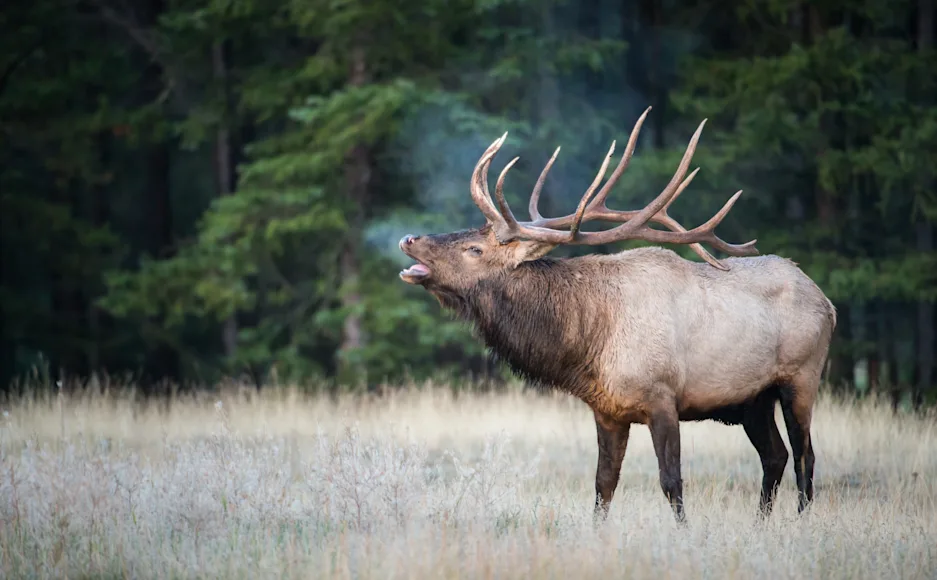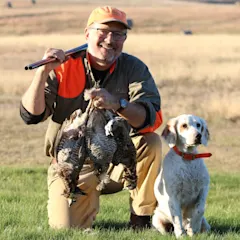
The Dream Bull
The scouting, training, and planning have all come down to this: Day one of elk season. Are you ready?
I’m lying on my back, afraid to move. The warning of never being more than a tuck and roll away from your rifle or bow is playing out before me. The breeze, or luck, must be in my favor, because whatever is in front of me sounds close—real close—and the shuffling of hooves and slurping of water has me guessing at all the possibilities. Then the smell hits me—that unmistakable, pungent, musty odor I’ve whiffed during so many close encounters. Elk.
I slowly raise my head and separate my toes to peer between my boot caps. Two mature bulls are drinking from a mountain spring 25 yards away, unaware of the hunter who has just woken up from an opening-day siesta. Scenarios play out in my head, but the bottom line is the same: If I move, I’m busted; if I don’t move, I’ll fail.
Today’s hunt technically started at 4 a.m., though I’d been scouting for weeks, and last night I didn’t sleep a wink—partly because my truck’s back seat was not roomy enough to stretch out on, and partly because I was so fired up for opening day. I’ve explored every crack and crevice of this range, though I never get tired of sweating a little more to see what’s over the next rise.
The archery season in my part of the Rockies typically spans that time when it’s not exactly summer but not yet fall, and since this opener’s forecast called for heat, I had wallows and water on the brain. I knew if I hiked with purpose up one drainage, crossed a ridge, and sat overlooking the water holes and wallows feeding into the next drainage, I might have a chance.
I’ve spent months training for this hunt—mentally, physically, and logistically. Strong legs and lungs and a sharp mind fill tags. No matter how much you prepare, though, the risk, as it is with every opener, is running into hunters. In a last-ditch effort to dissuade tailgaters, I strategically placed my two kids’ car seats in the back seat of my truck, hoping they’d scream, I’m a dad with young children looking for a little space to hunt—so piss off.
When I reached that first ridge, at the initial hint of daylight, I glassed down the drainage I had just hiked and didn’t see another headlight or headlamp. It’s taken a lot of time, money, and effort, but I’m where I want to be—alone, standing in the silence. Then I heard a bugle—a faint, throaty call, but a bugle all the same. I was still breathing heavily but attempted a half-hearted reply. Nothing answered back, so I pressed on.
I made camp 2 miles down the line on the only flat spot available at 8,500 feet. While the rest of the world clocked in to work, I glassed the neighboring basin while eating a bowl of instant oatmeal and spotted a loner spike, also eating breakfast alone. He looked up at my cow calls, but then vanished in the trees.
I eventually reached a freshwater spring I’ve sourced dozens of times. Fifty yards away, the trickle balloons into a wide, shallow wallow. When it’s too early to expect much rut activity, I’ve always found it best to sit patiently between the two and wait for an elk to come and drink, rather than bugle. A boss bull needs to be in its best shape possible before breeding, and that means drinking a lot of water.
The black bear and I didn’t see one another until it walked close enough to hit with a stick. I had a tag in my pack, but when I reached for my bow, he bolted. The adrenaline crash, fatigue, and comfort of the shade all hit me at once, and I drifted off—hard. Nearly an hour later, I woke up and realized I wasn’t alone. I assessed my situation. Had I been wiser, I would’ve napped behind a makeshift ground blind. Any one of the several fallen logs within eyesight would’ve helped to create a better outlook than the current view between my feet.
I wait for a moment to move, but there’s never a good window when you’re in the peripheral vision of an elk. As I roll to one side, a twig snaps. I freeze, but it doesn’t matter. The ruse is over. The last sight between my boot caps is of two yellow butts heading for higher ground.
I’m disappointed—but not defeated. There’s a lot of daylight left. Another water hole isn’t more than a quarter mile away, and it’s perfect for an afternoon ambush. Time to pick up the pace. Every joint in my body creeks and pops as I stand, secure my pack, grab my bow, and go. I can rest after elk season. —Ben Romans
Call up some Claws: How to Hunt Bobcats

As you celebrate the start of another big-game season, remember that the opportunity to tag prize predators is likely already open in the West and can offer some big excitement if you fill your other tags early or just want to spend some time targeting clawed critters.
You’ll want to review the hunting regulations for your area closely, of course. But most Western states have long predator seasons with generous quotas and allow the use of electronic calls.
Be ready to take advantage of those regs by keeping a few predator calls in your pack or stashing a remote electronic caller in your vehicle. Pull them out at the conclusion of your big-game hunt or when there’s obvious evidence of predators in your area, like coyotes yipping in the distance.
Read Next: The Best Coyote Calls
Start by mimicking something small and suffering, such as a distressed fawn, calf, varmint, or rodent. Just be prepared for anything. Distress calls can attract bears, wolves, coyotes, foxes, bobcats, and lions. There’s nothing quite like watching a coyote or wolf materialize in the timber or suddenly appear in the wide open, trotting right to you. I’ve also had bears come to my cow elk calls, and lions slip in on my coyote cries. You never know what might show up, and that’s half the fun. —B.R.

How to Hunt the Pronghorn Rut
The pronghorn rut might be the most under-appreciated hunting experience in North America. If a big buck takes a break from chasing does at 50 mph, it’s because he’s seen another buck that needs a beating. Antelope take their loving seriously.
The best activity is from mid-September through early October, which coincides with many states’ muzzleloader and rifle openers. It’s also one of my favorite times to hunt with a bow. Getting within range of a buck during the rut can be a challenge. But with so many animals on the move, you can narrow the odds by taking a play from the whitetail hunter’s handbook.
1. Find an Opening
Antelope do not like to cross fences. You’ll sometimes see a buck squeeze under barbed wire, but he’s just as likely to run alongside it for a mile until he finds an easier crossing. Fence gaps are deadly ambush points. Set a trail camera in a gap to see if good bucks are using it, or simply glass from a distance. The ideal scenario has small herds on both sides of the gap. Does will meander back and forth, and bucks on both sides will inevitably see and challenge one another.
2. Lie in Wait
Rifle hunters should set up within a couple hundred yards of the gap for a shot. Lie prone next to some cover, such as a yucca or two, and keep still. If you’re hunting with an open-sighted muzzleloader or a bow, erect a pop-up blind 30 to 50 yards from the fence gap. Though antelope use their eyes far more than their noses, they’ll spook if they smell you. So keep the wind in your favor as much as you can.
3. Run a Fake
If you’re patient and there are antelope around, you can almost count on getting a shot at the fence gap. But you’ll need to stretch or scratch something at some point during your wait, and that’s probably when a buck you haven’t seen will catch you moving. A pop-up Montana Decoy weighs next to nothing and can be deployed in a second or two (just be careful and check regs during firearms season). A deke might save you from being busted—and if you’re lucky, bring your buck in on the run. —Will Brantley
Hunt Down the Huns
You know the old saw about fishing: 90 percent of the fish live in 10 percent of the water. It’s the same with Hungarian partridge on the High Plains. Faced with the enormity of the landscape, how do you narrow things down and put yourself in position to make hay on these tough, elusive, gloriously challenging gamebirds?
For guide and professional gun-dog trainer Nolan Huffman of Lewis town, Montana, opening-day success is a two-part recipe. “Early in the morning, when temperatures are comparatively cool, I like to hunt recently cut alfalfa fields,” Huffman says. “These spots are loaded with grasshoppers then, and Huns will feed on those hoppers for as long as they’re available.”
Then, as the temperature creeps the middle of the day,” he says, “I concentrate on brushy draws where the birds go for shade. They like to be close to water too, so if I can find brushy cover near a stock dam, I feel really good about my chances.”
Perhaps the ideal setup, though, is a seep coming out of a draw.
“That little extra moisture is usually enough to produce a patch of chokecherries,” Huffman says. “And wherever you find water and shade in the same place, you’re very likely to find Huns.” —T.D.
Opening Day Tradition: The Toast
Years ago, my father and I started hunting elk in a collection of basins in central Idaho. But not together. I hunt it on the archery opener because the elk are uneducated. My father likes to hit it solo at the end of bow season because he enjoys the colder air, and he thinks that tackling the hike in and out alone proves he’s not too old for this. The best place to bivy camp sits on an 8,500-foot ridge overlooking more country than I can glass.
After his first solo trek, Dad left a cache of bourbon and firewood near camp. He buried the flask in a hole, then stacked a small collection of tinder and kindling on top. The treasure and marker sat for 11 months until I came around the ridge again. We’ve kept up the ritual every year since. I think he likes knowing he’s left something behind should there be a year he can’t make it up. I like it because I always end my first day sitting next to a fire, toasting another season. —B.R.



